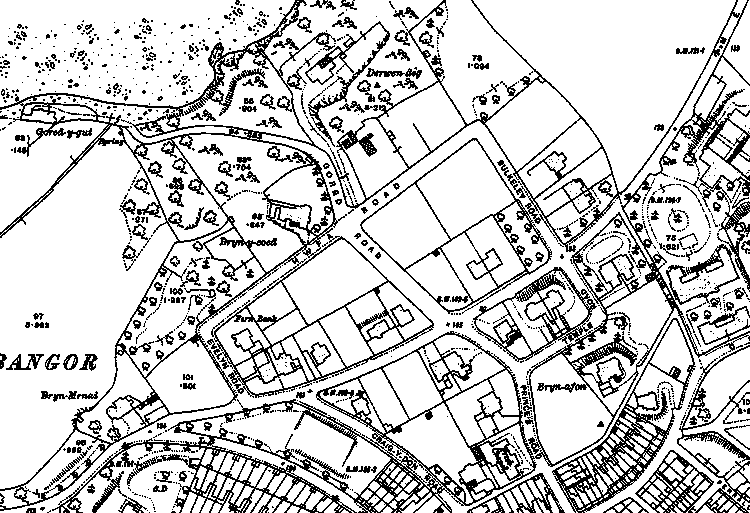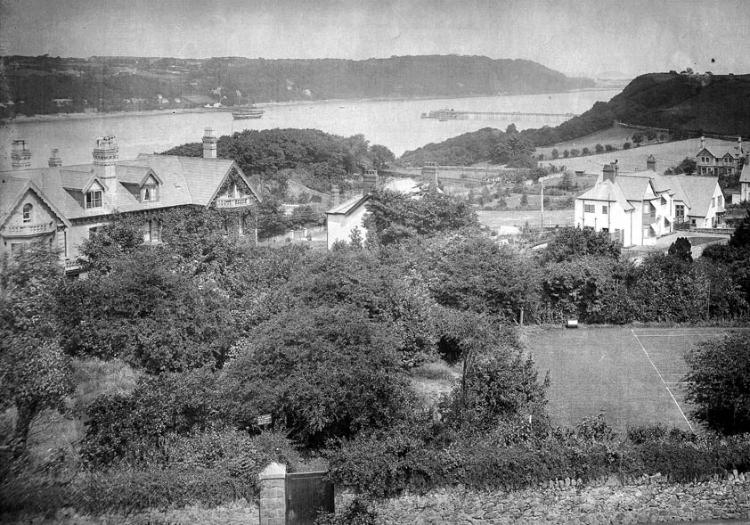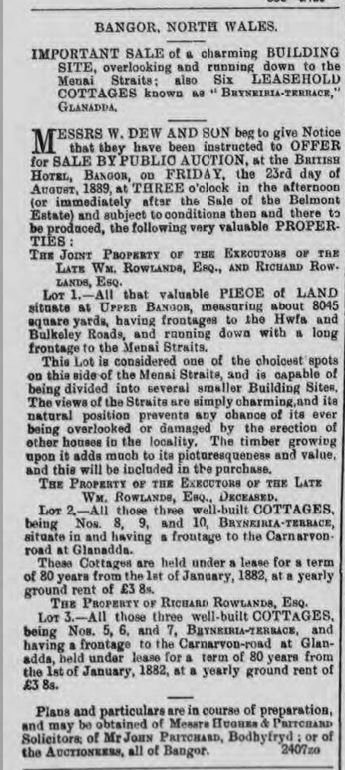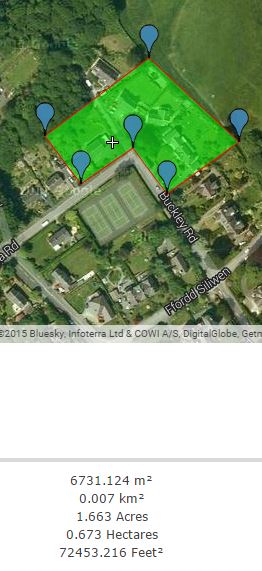Bangor Civic Society | Message Board & Forum
› General
›
City, Buildings, Businesses and Land History
Dwellings off Siliwen Road
|
|
This post was updated on .
   Looking down to the Menai Strait from Upper Bangor. Image taken from or near Bryn Afon. The building to the left is Menai Dale, a substantial semi detached dwelling (further to the left out of picture is the other half Bron Hwfa). The building to the right is a side view of Neuadd Ogwen, part of the University Estate and for many years now the home of the School of History & Archeology, more recently Social Sciences. Formerly a hall of residence for Female students of the Normal College The road junction is a crossroads between Siliwen Road (Ffordd Siliwen) running left to right, Buckley Road (Bwclae Road) in the distance and Temple Road (Lon Temple) - nearest. The dwelling on Buckley Road, central in the picture, is again a substantial semi detached property. Weirglodd Wen is the nearest section and Dol Menai is the second. Both commanding views of Siliwen Road fields.  
|
|
|
Dol Menai was at a point the home of
ROWLEY , HAROLD HENRY ( 1890 - 1969 ), professor, scholar and author ; b. 24 Mar. 1890 at Leicester , son of Richard and Emma Rowley . He went to Bristol Baptist College and Mansfield College , Oxford , graduating M.A. at Bristol , B.Litt. at Oxford and D.D. of London University . He won many prizes and scholarships, including the Houghton Syriac Prize . He was minister of the United Church (B and Congl.) at Wells , Somerset ( 1917-22 ) and a missionary in China ( 1922-30 ) where he was an Associate Professor at Shantung Christian University . He came to Wales in 1930 as a lecturer in Semitic languages at University College , Cardiff and afterwards was appointed Professor of Hebrew and Semitic Languages at the University College , Bangor ( 1935-45 ) and Dean of Bangor School of Theology ( 1936-45 ), and was respected as a hard worker and severe disciplinarian. He moved to the Chair of Semitic languages at Manchester University in 1945 , where he was Dean of the Faculty of Theology of the University ( 1953-56 ), remaining there until his retirement in 1956 . He was also president of the Baptist Union of Britain ( 1957-58 ). Among his numerous published works are: Darius the Mede and the four world empires in the Book of Daniel ( 1935 ), The Relevance of the Bible ( 1942 ), The Relevance of Apocalyptic ( 1944 ), The Growth of the Old Testament ( 1950 ), The Biblical Doctrine of Election ( 1950 ), From Joseph to Joshua ( 1950 ). He also published three collections of articles, The Servant of the Lord ( 1952 ), Men of God ( 1963 ) and From Moses to Qumran ( 1963 ), and he was editor of a number of books and of The Jnl. of Semitic Studies ( 1956-60 ). His work is characterised by extensive footnotes, which provide endless sources for researchers. In his day he was one of the most well-known Old Testament scholars throughout the world, as may be gathered from the honours bestowed upon him: honorary doctorates of the universities of Durham , Wales , Oxford , Manchester , Edinburgh , Uppsala , Zürich , Marburg , McMaster and Strasbourg ; being made an honorary member of learned societies in several countries ; a Fellow of the British Academy and awarded its Burkitt medal for Biblical studies . It was he, more than anyone, who succeeded in bringing Old Testament scholars into contact with each other after World War II ; he was secretary of the Society for the Study of the Old Testament ( 1946-60 ), and its president ( 1950 ). In 1918 he m. Gladys B. Shaw and they had a son and three daughters. He went to live in Stroud after retiring and d. there 4 Oct. 1969 . |
|
|
Weirglodd Wen was at a point the home of
FYNES-CLINTON , OSBERT HENRY ( 1869 - 1941 ), Professor of French and Romance Philology at the University College of North Wales, Bangor ; b. 9 Nov. 1869 , son of the Rev. Osbert Fynes-Clinton , rector of Barlow Moor , Didsbury . A graduate of St. John's College , Oxford , he was elected Taylorian Scholar of the University in Spanish in 1892 . He was French master at King Edward's School , Aston , Birmingham from 1896 to 1904 , when he was appointed Professor of French and Romance Philology at the University College of North Wales , a position which he held until 1937 when he retired and was appointed Professor Emeritus . A brilliant linguist , he devoted his leisure hours to a meticulous study of the Arfon dialect of Welsh , and in 1913 published The Welsh Vocabulary of the Bangor District , which secured for him a place of honour in the history of Welsh linguistics, being the only comprehensive phonetic study of the vocabulary of a Welsh dialect hitherto published. In recognition of his work the University of Wales in 1939 conferred on him the honorary degree of D.Litt. He d. 9 Aug. 1941 . |
|
|
In reply to this post by Admin (Matt)
 Amusing rear to the card, dated Nov 13th 1907 |
|
|
In reply to this post by Admin (Matt)
These houses were built on land purchased by Thomas Peers Williams in 1842 from the Penrallt Estate which ran from (and inclusive of) College Road. But was not put on the property market until 1880. Williams died in 1875. The land thereafter was laid out in villa plots and specific stipulations were made to purchasers who employed their own architects. Resulting in a variation of styles in low density.
A deceleration in economic growth may have led to 20 plots remaining unsold until 1914 and the resulting mixed age of dwellings with newer styles prevalent lower down towards the staits. |
|
|
This post was updated on .
In reply to this post by Admin (Matt)
 History of the Buckley Road Tennis Courts nearby.... Bangor LTC was formed in 1924. Previously, it had been a private club, and was called Glyndyl after the first names of the owners, Ioan Y Glynne, a prominent local solicitor, and his wife, Dylis. There were only two courts at this time, but a third court and the pavilion were added in 1926. Club nights were an early feature of the club. Members wrote their names on a slate on arrival on club evenings to ensure that everyone played in turn. The courts were made up of grey shale, a surface similar to clay courts, which required frequent watering, rolling and brushing, and, for many years, the club employed a groundsman who looked after the courts and the surrounds. There were many clubs in the vicinity at that time, and matches were regularly played against teams from Penmaenmawr, Menai Bridge, Caernarfon, Holyhead and UCNW. In the 1930’s Bangor regularly reached the final of the North Wales Inter Club championships, but were usually beaten by Prestatyn LTC. The club carried on functioning during World War 2, but all matches were cancelled. It was at this time that members were first allowed to play on Sundays. After the war the club grew rapidly – the membership fee set for the1948/9 season was £1-15 shillings, which rose to £2-5 shillings in 1953. Junior coaching was introduced in the 1950’s, when a Monday evening was set aside for juniors to learn to play. By the 1970’s there were sessions held every evening, with end of season tournaments proving very popular. In the 50’s senior club tournaments were held annually. Typical prizes for the era were a cup each for the winners of the men’s and ladies’ singles and cufflinks and a brooch for the runners up. In the 1970’s, the courts were resurfaced with ‘gra-green’, a sort of tarmac with a topping of grit at a cost of £3,000. The club received a grant from the Sports Council for Wales and a loan from the LTA to fund this project. However, these courts were not a great success, and soon deteriorated. In 1981 the grit was taken away and a bitumised paint applied to the surface, which kept them going for a little while longer. They were completely resurfaced again in 1987 with Tennisquick, the present surface, at a cost of £20,000, again with help from the Sports Council and a grant from Arfon Borough Council. Many club members have represented North Wales at county senior and junior level, and three members have represented Wales at senior level. It is hoped that the club will continue to flourish so that we can celebrate our centenary in 2024! Margaret Lewis http://www.bangortennisclub.co.uk/ The below could refers to the tennis courts land... (1889)   8045 square yards being 6727 m^2 (square meters) this would have included the other land in the square minus the property facing Siliwen Road.  or or  |
|
|
In reply to this post by Admin (Matt)
Thomas Peers Williams, the grandson of Thomas Williams, the'Copper King' of Parys Mountain, lived at Craig-y-Don, directly opposite Upper Bangor near Cadnant, Glyn Garth, which is why he called the new road Craig-y-Don Road. Evelyn and Hwfa Roads were named after two of his children. His daughter Margaret married Sir Richard Williams-Bulkley which explains Bulkley Road. Temple Road gets its name from Temple House, the grand mansion that the Copper King built for himself at Great Marlow, Berkshire.
|
|
|
This post was updated on .
In reply to this post by Admin (Matt)
Thanks David!

Click image to go to zoomable image. Old Panorama of the area. Showing: Bryn Y Coed (far left) - on Hwfa Road Cilrhedyn (left) - on Evelyn Road Gwaen Deg (& Elm Bank - semi) - on Siliwen Road - Gwaen Deg was home of Sir John Edward Lloyd (1861–1947), Emeritus Professor of History, University Trewern - on Craig Y Don Road |
|
|

c1889 A Short History of the Anglican Chaplaincy in Bangor http://chaplaincy.bangor.ac.uk//history.htm Every story is unique to its context, but the history of Anglican Higher Education Chaplaincy in Bangor is perhaps more unique than most! Shortly after the foundation of the University College in 1884, the Church of England (as it was then) decided that it needed a stake in the new educational venture at Bangor. The northern Welsh dioceses of St Asaph and Bangor joined together to fund a house and clergyman to work alongside the College. A private house called Craig Menai was bought in 1886 and came to be known as Church Hostel. The project was heavily influenced by H.T. Edwards, Dean of Bangor, and represented an outgrowth of the Bangor Clerical Educational Society with which Edwards was closely involved. The initial function of the Hostel and its Warden was thus largely geared to developing potential clergy during their time at University before they went to theological college. The building expanded in line with the growth of the University College and the numbers of young men seeking ordination. The present chapel, and rooms 1 to 10 were built under the Wardenship of Glyn Simon in 1933, with a free-standing library added five years later. A study of Herbert North the local Arts and Crafts architect who oversaw this work has recently been published by Adam Voelcker and is available from the Royal Commission on the Ancient and Historical Monuments of Wales. Another large extension in 1953-54 created rooms 11 to 21. The library was converted at the turn of the millennium into a flexible multi-media space available for public hire. A major refurbishment in early 2009 renovated all our washrooms and created an additional three bedrooms, rooms 26 to 28. Even from its inception, Church Hostel was intended to exercise a wider function as a physical base for Anglican activity within the University College, a role recognised today as one of Chaplaincy to all students and staff. The Chaplain / Warden's tasks have sometimes been facilitated by contributing to the lecturing life of the School of Theology and Religious Studies. The aim of the Chaplaincy remains the combination of these various tasks and opportunities so that the love of Christ for individuals and society can be demonstrated: 'Christian worship and service by and for members of the University.' The above information draws on Barry Morgan's History of the Church Hostel and Anglican Chaplaincy at University College of North Wales Bangor 1886-1986, which is available through second-hand booksellers over the internet. All of Church Hostel's significant archive material is on deposit with Bangor University Archive Service. |
«
Return to City, Buildings, Businesses and Land History
|
1 view|%1 views
| Free forum by Nabble | Edit this page |

